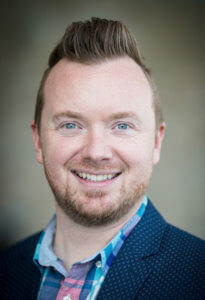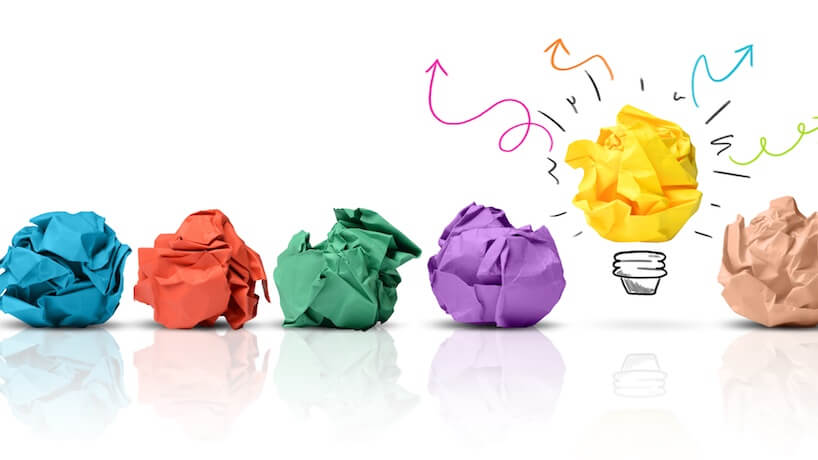When Phil Hansen first felt an uncontrollable tremor in his hand due to nerve damage in his forearm, he figured his dream of being an artist was done. He dropped out of art school. “The mindset was simple,” Hansen told PCMA via email in advance of his appearance at the PCMA Education Conference in Cleveland, June 10–13. “You can’t be an artist with a shaky hand. But now, I see that I was only looking at one piece of the puzzle.”
 The rest of the pieces came together when Hansen stopped thinking in terms of limitations — his own and what constitutes “art.” Hansen has appeared on Good Morning America, CNN, The Rachael Ray Show, and a range of other international outlets to share his creative vision. That vision includes painting with the grease of french fries, making portraits with smashed vinyl records, tattooing bananas with a thumbtack, and a range of other innovative techniques that redefine art.
The rest of the pieces came together when Hansen stopped thinking in terms of limitations — his own and what constitutes “art.” Hansen has appeared on Good Morning America, CNN, The Rachael Ray Show, and a range of other international outlets to share his creative vision. That vision includes painting with the grease of french fries, making portraits with smashed vinyl records, tattooing bananas with a thumbtack, and a range of other innovative techniques that redefine art.
You hope to create a public dialog with art through your work. Can you share some insights into how that conversation has sounded at other conferences and conventions?
I’m able to visualize things that seem a little of the ether by using my art as a backdrop in my talk. I’m able to show what working within the box — working within the confines of life — can lead to. The conversations that come out of this are fascinating. First, you’ll have leaders on stage who immediately echo some of the points such as staying open for collaborating [to help inspire] a shift in our own perspective. People will stop me in the hallway [after my presentation] and tell me that they just got off the phone with their kid, telling them about the art they saw and ideas they just heard hoping that this outsider (me) could help their kid see a challenge differently. And I always have people who come up after my speech who want to ask questions that relate to their limitations and challenges in the work they do. The variety of conversations becomes a beautiful insight to the quilt of life where all these different pieces fit together to create something beautiful.
Your recent work involves a wide range of supplies that might not sound like conventional art materials: typewriters, bacon, and pinecones. What guides your decisions when choosing products and materials to inspire your artistic expression?
Like the variety of materials I use to create, there are a variety of ways I choose materials. Sometimes, I want to push myself creatively so I will just find something I’ve never created with before and challenge myself with it. Other times, I will look for a material that fits an idea. That is how using a typewriter came about. I have always been interested in how certain phrases from movies, music, family members or friends stick with us. I wanted to find a way to visualize phrases becoming people. I’ve worked with text many times before but never with a typewriter or on such a small scale. It seemed like an interesting challenge, and it intrigued me to explore it.
How can your open-mindedness to working with new and unexpected materials translate to leading a business or building an event?
No matter what we are creating in life, it all starts with the basics. We need to have the skills, the ideas, and the motivation to do the work. After that, it becomes about working with what we know to solve our challenge and possibly explore new avenues. Leading a business or building an event takes constant iterative development, continuous exploration, and a willingness to take hold of [what seem like] failures but not be defined by them. At the end of the day, both failures and successes are simply points of transition on the continuation of life. Taking on the challenge ahead with the information and skills we have combined with a novice mindset will keep us open to new ways of seeing things.
Your approach has been shaped by what seemed like a setback. How has the nerve damage to your forearm impacted your philosophy on your professional art and your personal life?
All of our challenges in life are composed of two parts — the limitation (in my case a shaky hand) and our belief about that limitation (I believed one couldn’t be an artist if he or she had a tremor in his or her hand). My current mindset when running into challenges is to look at the two parts of a challenge and work on each one as its own. Oftentimes our beliefs hold us back. If we look past our beliefs, get out of our own way, and get creative with the limitation, we can make amazing changes in our lives.
For event professionals who have never seen you before, what can they do to prepare to learn from your presentation in Cleveland? And what are some of the key lessons you hope they take home?
Preparing for my presentation is simple: Get ready to see art in a way you hopefully haven’t before. Be open to this crazy journey I’ve been on. Be ready to make some itty-bitty drawings. The take-home is simple to understand but takes effort to execute. It’s the idea that our limitations can be our greatest source of creativity. By identifying our beliefs about how limitations affect us, we can free ourselves from their grasp and find ourselves creating more freely than ever before.
Click here to check out more of Hansen’s work, and go here to register for the PCMA Education Conference to catch him face-to-face.

